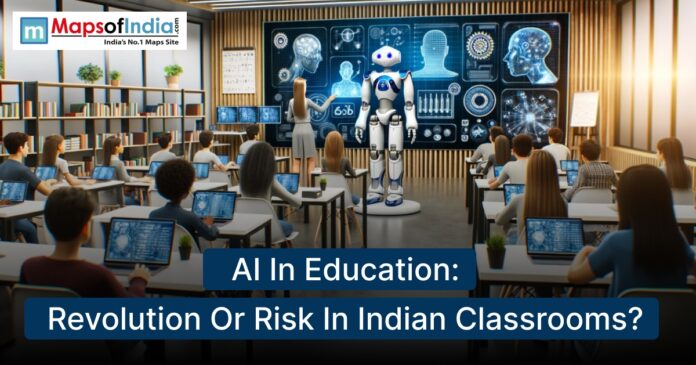The swarm of Artificial Intelligence (AI) has reached almost every sector, and education is not an exception, either. The terrorist attack in India has been considered a technical revolution as the country has many tools that have been solved by the arrival of AI-driven instruments in education, a sector that is both huge and diverse. AI can revolutionize classrooms, making them centre’s of smart learning: individual instructors, automated grading, etc. Yet, as we learn more about this digital transformation, the questions arise: Is it correct to claim that AI is a revolution in the field of Indian education, or will it have a concealed danger with it?
The Promise of AI in Indian Education
1. Personalized Learning Paths
The argument to personalize education with AI is one of the most compelling AI opportunities out there. Personal attention is an expensive luxury in a country such as India, where the student-teacher ratio tends to be unbalanced, with some cases as high as 50:1 in government-run schools. Such platforms as BYJU or Toppr utilize AI, based on the student data they analyze, to streamline the content in accordance with weaknesses, strengths, and learning speed. Such a form of adaptive learning can ensure that students who have difficulties will be able to get back on track, and the ones who are more advanced will not be slowed down to the pace of the general population using a one-size-fits-all curriculum.
2. Bridging the Language Divide
Language diversity is a special challenge in classrooms in India. This gap can be closed with AI-enabled tools that offer real-time multilingual support and translate it in real-time. Apps such as the Bolo (read as Read Along) created by Google, rely on speech recognition and help children learn both how to read in their own language and how to read in English, so that basic literacy skills can become more inclusive.
3. Enhanced Accessibility for Students with Disabilities
AI can be a game changer for the differently-abled students. The software programmes of visual and speech recognition can facilitate visually impaired students to read aloud the written word of the textbook. Speech-to-text software helps individuals with motor problems finish their tasks. These innovations not only open the doors to learning but also encourage inclusivity in ordinary classrooms.
4. Automated Administrative Tasks
Indian teachers tend to have so much workload, especially in administration, and this includes marking assignments, making reports. The educators will have more time to teach, and this is achievable because AI can handle most of these functions. The AI may also be used to analyze objective assessments, identify patterns in student performance, and even propose teaching interventions.
5. Data-Driven Decision Making
Through the analysis of massive amounts of information, the AI systems will be able to give some hints about the student performance patterns, drop-out risks, and the efficiency of the instructional strategies. Such analytics would help schools and policymakers to make more informed decisions, which might eventually help increase the overall quality of education.
The Risks and Challenges of AI in Indian Classrooms
Though the scope of AI in education is huge, its application is not without risks, particularly in the Indian context. Blind implementation may be more disastrous than positive.
1. Widening the Digital Divide
Digital infrastructure in India is still heterogeneous, more so in rural and poor areas. Most of the schools in the government can do without the internet, whereas the main metropolitan schools may have the benefit of smart classrooms and AI instruments. The drive to AI threatens to widen the educational disparity rather than elevating those who are already looked down on.
2. Job Displacement and Teacher Redundancy
Of greatest concern, would AI make teachers obsolete? It could be that tutoring systems and grading programs are efficient, but they will never be able to substitute the human factor brought to the classroom by a teacher. Over-reliance on AI in a country where millions of people are employed due to the teaching profession may be disruptive to livelihoods, as well as a possible source of job destruction.
3. Data Privacy and Ethical Concerns
AI is known to operate using the data gathered and analyzed data about the students including sensitive personal data. To a country that is still developing the concept of data protection, this is a serious breach of privacy. On It there are questions of who the data belongs to, how it would be used and even whether students and parents can opt out.
4. Algorithmic Bias
AI systems merely perform as instructed, which means as well as what they are taught. When there are biases in the datasets to be used, such as a lot of overrepresentation of urban English-speaking students, the AI can be used to reproduce these biases. Such systems may misjudge or wrongly evaluate students of the rural, vernacular or tribe background.
5. Over-Standardization and Loss of Creativity
Although there is a possibility to maximize learning routes through AI, the risk lies in the fact that the education could be over-standardized. In the Indian classroom situation, classrooms are already very exam-oriented. As AI places the value on quantifiable results etc., the more creative and human side of learning, creativity, critical thinking, and empathy may be in the shadows.
AI and Indian Education Policy
The Indian government has begun to implement changes on a policy level, knowing the exciting potential of AI. The National Education Policy 2020 refers to the application of technology and the adoption of AI in enhancing learning outcomes. The Ministry of Education has introduced such measures as SWAYAM or DIKSHA, which use AI to provide quality educational content online. Even in its National Strategy on Artificial Intelligence, NITI Aayog continues to single out education as one of the five leading sectors where an intervention of AI is envisioned.
A lot of this policy trend, however, is immature. A powerful regulatory framework is needed, capable of balancing access to AI, securing data, and preparing educators who would cooperate with AI, rather than compete with it.
The Role of Teachers in an AI-Powered Classroom
The worry that AI will end up replacing teachers is somewhat ill-founded, provided that we apply it properly. AI should perform the role of an assistant or a co-teacher, rather than substitute for an educator. The AI can provide educators with more information about their students’ development level and individualize their lessons. The trick is that teachers should have the appropriate training to comprehend these tools and apply them. Unless teachers are involved in it, the implementation of AI is going to be half-baked.
In addition, human teachers introduce such things as emotional intelligence, mentoring and contextual judgment, which cannot be programmed. In India, in a society where students tend to see teachers as role models in a moral and cultural sense, this role is sacred.
What Needs to Be Done?
The following are some of the steps that must be implemented so as to make sure that AI is more of a revolution than a risk:
- Development of Digital Infrastructure: Develop a network of access to the internet and devices in all schools and in rural areas in particular.
- Teacher Training: Ensure national teacher training on AI literacy and strategies on the integration of AI.
- Ethical Guidelines: Develop explicit policies on information gathering, data retention and utilization that would uphold the confidentiality of students.
- Local Language Integration: Artificial intelligence tools should adopt local languages because every person will feel included.
- Public-Private Partnerships: Stimulate the work of the government and ed-tech companies to integrate AI at a large scale.
Conclusion: Treading the Fine Line
The situation of AI in the Indian classroom is of change, of a revolution, that can possibly redefine the very way millions of students learn, develop and shape the future. However, there is a price to pay with this transformation. On the route to smart classrooms, equity, care and ethics have to be equivalent to bricks.
Given this new ground, there is one thing we know, the AI is not a magic wand but a strong tool. It is up to us on how we use it to make it a bridge to high quality education or to become a segregator of quality education. We must aim at amplifying the existing teachers, not deposing them, helping students rather than spying on them, and creating classrooms where intelligence, artificial or human, collaborates to create a better future for the Indian students.




